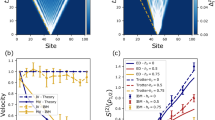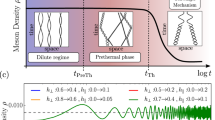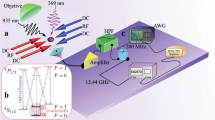Abstract
Particles subject to confinement experience an attractive potential that increases without bound as they separate. A prominent example is colour confinement in particle physics, in which baryons and mesons are produced by quark confinement. Confinement can also occur in low-energy quantum many-body systems when elementary excitations are confined into bound quasiparticles. Here we report the observation of magnetic domain-wall confinement in interacting spin chains with a trapped-ion quantum simulator. By measuring how correlations spread, we show that confinement can suppress information propagation and thermalization in such many-body systems. We quantitatively determine the excitation energy of domain-wall bound states from the non-equilibrium quench dynamics. We also study the number of domain-wall excitations created for different quench parameters, in a regime that is difficult to model with classical computers. This work demonstrates the capability of quantum simulators for investigating high-energy physics phenomena, such as quark collision and string breaking.
This is a preview of subscription content, access via your institution
Access options
Access Nature and 54 other Nature Portfolio journals
Get Nature+, our best-value online-access subscription
$29.99 / 30 days
cancel any time
Subscribe to this journal
Receive 12 print issues and online access
$209.00 per year
only $17.42 per issue
Buy this article
- Purchase on Springer Link
- Instant access to full article PDF
Prices may be subject to local taxes which are calculated during checkout




Similar content being viewed by others
Data availability
The data presented in the figures of this Article are available from the corresponding authors upon reasonable request.
Code availability
All custom code used to support claims and analyse data presented in this Article is available from the corresponding authors upon reasonable request.
References
Greensite, J. An Introduction to the Confinement Problem 1–2 (Springer, 2011).
Brambilla, N. et al. QCD and strongly coupled gauge theories: challenges and perspectives. Eur. Phys. J. C 74, 2981 (2014).
McCoy, B. M. & Wu, T. T. Two-dimensional Ising field theory in a magnetic field: breakup of the cut in the two-point function. Phys. Rev. D 18, 1259–1267 (1978).
Delfino, G. & Mussardo, G. The spin-spin correlation function in the two-dimensional Ising model in a magnetic field at T = TC. Nucl. Phys. B 455, 724–758 (1995).
Fonseca, P. & Zamolodchikov, A. Ising spectroscopy I: mesons at T < TC. Preprint at https://arxiv.org/abs/hep-th/0612304 (2006).
Lake, B. et al. Confinement of fractional quantum number particles in a condensed-matter system. Nat. Phys. 6, 50–55 (2010).
Coldea, R. et al. Quantum criticality in an Ising chain: experimental evidence for emergent E8 symmetry. Science 327, 177–180 (2010).
Kormos, M., Collura, M., Takács, G. & Calabrese, P. Real-time confinement following a quantum quench to a non-integrable model. Nat. Phys. 13, 246–249 (2017).
Lerose, A., Žunkovič, B., Silva, A. & Gambassi, A. Quasilocal excitations induced by long-range interactions in translationally invariant quantum spin chains. Phys. Rev. B 99, 121112 (2019).
James, A. J. A., Konik, R. M. & Robinson, N. J. Nonthermal states arising from confinement in one and two dimensions. Phy. Rev. Lett. 122, 130603 (2019).
Liu, F. et al. Confined quasiparticle dynamics in long-range interacting quantum spin chains. Phys. Rev. Lett. 122, 150601 (2019).
Mazza, P. P., Perfetto, G., Lerose, A., Collura, M. & Gambassi, A. Suppression of transport in nondisordered quantum spin chains due to confined excitations. Phys. Rev. B 99, 180302 (2019).
Lerose, A. et al. Quasilocalized dynamics from confinement of quantum excitations. Phys. Rev. B 102, 041118 (2020).
Verdel, R., Liu, F., Whitsitt, S., Gorshkov, A. V. & Heyl, M. Real-time dynamics of string breaking in quantum spin chains. Phys. Rev. B 102, 014308 (2020).
Santos, L. F., Borgonovi, F. & Celardo, G. L. Cooperative shielding in many-body systems with long-range interaction. Phys. Rev. Lett. 116, 250402 (2016).
Feynman, R. P. Simulating physics with computers. Int. J. Theor. Phys. 21, 467–488 (1982).
Georgescu, I. M., Ashhab, S. & Nori, F. Quantum simulation. Rev. Mod. Phys. 86, 153–185 (2014).
Görg, F. et al. Realization of density-dependent Peierls phases to engineer quantized gauge fields coupled to ultracold matter. Nat. Phys. 15, 1161–1167 (2019).
Schweizer, C. et al. Floquet approach to \({\mathbb{Z}}_2\) lattice gauge theories with ultracold atoms in optical lattices. Nat. Phys. 15, 1168–1173 (2019).
Mil, A. et al. A scalable realization of local U(1) gauge invariance in cold atomic mixtures. Science 367, 1128–1130 (2020).
Muschik, C. et al. U(1) Wilson lattice gauge theories in digital quantum simulators. New J. Phys. 19, 103020 (2017).
Brenes, M., Dalmonte, M., Heyl, M. & Scardicchio, A. Many-body localization dynamics from gauge invariance. Phys. Rev. Lett. 120, 030601 (2018).
Bañuls, M. C. et al. Simulating lattice gauge theories within quantum technologies. Eur. Phys. J. D 74, 165 (2020).
Borla, U., Verresen, R., Grusdt, F. & Moroz, S. Confined phases of one-dimensional spinless fermions coupled to \({\Bbb{Z}}_2\) gauge theory. Phys. Rev. Lett. 124, 120503 (2020).
Porras, D. & Cirac, J. I. Effective spin systems with trapped ions. Phys. Rev. Lett. 92, 207901 (2004).
Bohnet, J. G. et al. Quantum spin dynamics and entanglement generation with hundreds of trapped ions. Science 352, 1297–1301 (2016).
Jurcevic, P. et al. Direct observation of dynamical quantum phase transitions in an interacting many-body system. Phys. Rev. Lett. 119, 080501 (2017).
Zhang, J. et al. Observation of a many-body dynamical phase transition with a 53-qubit quantum simulator. Nature 551, 601–604 (2017).
Halimeh, J. C. & Zauner-Stauber, V. Dynamical phase diagram of spin chains with long-range interactions. Phys. Rev. B 96, 134427 (2017).
Žunkovič, B., Heyl, M., Knap, M. & Silva, A. Dynamical quantum phase transitions in spin chains with long-range interactions: merging different concepts of nonequilibrium criticality. Phys. Rev. Lett. 120, 130601 (2018).
Magnifico, G. et al. Real time dynamics and confinement in the \({{\Bbb{Z}}}_{n}\) Schwinger–Weyl lattice model for 1+1 QED. Quantum 4, 281 (2020).
Kim, K. et al. Entanglement and tunable spin-spin couplings between trapped ions using multiple transverse modes. Phys. Rev. Lett. 103, 120502 (2009).
Pagano, G. et al. Cryogenic trapped-ion system for large scale quantum simulation. Quantum Sci. Technol. 4, 014004 (2018).
Lee, A. C. et al. Engineering large Stark shifts for control of individual clock state qubits. Phys. Rev. A 94, 042308 (2016).
Calabrese, P. & Cardy, J. Time dependence of correlation functions following a quantum quench. Phys. Rev. Lett. 96, 136801 (2006).
Cheneau, M. et al. Light-cone-like spreading of correlations in a quantum many-body system. Nature 481, 484–487 (2012).
Eisert, J., Friesdorf, M. & Gogolin, C. Quantum many-body systems out of equilibrium. Nat. Phys. 11, 124–130 (2015).
Bañuls, M. C., Cirac, J. I. & Hastings, M. B. Strong and weak thermalization of infinite nonintegrable quantum systems. Phys. Rev. Lett. 106, 050405 (2011).
Schreiber, M. et al. Observation of many-body localization of interacting fermions in a quasirandom optical lattice. Science 349, 842–845 (2015).
Nandkishore, R. & Huse, D. A. Many-body localization and thermalization in quantum statistical mechanics. Annu. Rev. Condens. Matter Phys. 6, 15–38 (2015).
Hess, P. W. et al. Non-thermalization in trapped atomic ion spin chains. Phil. Trans. R. Soc. A 375, 20170107 (2017).
del Campo, A. & Zurek, W. H. Universality of phase transition dynamics: topological defects from symmetry breaking. Int. J. Mod. Phys. A 29, 1430018 (2014).
Calabrese, P., Essler, F.H.L. & Fagotti, M. Quantum quenches in the transverse field Ising chain: II. Stationary state properties. J. Stat. Mech. 2012, P07022 (2012).
Abanin, D., Roeck, W. D., Ho, W. W. & Huveneers, F. A rigorous theory of many-body prethermalization for periodically driven and closed quantum systems. Commun. Math. Phys. 354, 809–827 (2017).
Halimeh, J. C. et al. Prethermalization and persistent order in the absence of a thermal phase transition. Phys. Rev. B 95, 024302 (2017).
Tran, M. C. et al. Locality and heating in periodically driven, power-law interacting systems. Phys. Rev. A 100, 052103 (2019).
Machado, F., Else, D. V., Kahanamoku-Meyer, G. D., Nayak, C. & Yao, N. Y. Long-range prethermal phases of nonequilibrium matter. Phys. Rev. X 10, 011043 (2020).
Essler, F. H. L., Kehrein, S., Manmana, S. R. & Robinson, N. J. Quench dynamics in a model with tuneable integrability breaking. Phys. Rev. B 89, 165104 (2014).
Vovrosh, J. & Knolle, J. Confinement dynamics on a digital quantum computer. Preprint at https://arxiv.org/abs/2001.03044 (2020).
Mølmer, K. & Sørensen, A. Multiparticle entanglement of hot trapped ions. Phys. Rev. Lett. 82, 1835–1838 (1999).
Wineland, D. J. et al. Experimental issues in coherent quantum-state manipulation of trapped atomic ions. J. Res. Natl Inst. Stand. Technol. 103, 259–328 (1998).
Schachenmayer, J., Lanyon, B. P., Roos, C. F. & Daley, A. J. Entanglement growth in quench dynamics with variable range interactions. Phys. Rev. X 3, 031015 (2013).
Neyenhuis, B. et al. Observation of prethermalization in long-range interacting spin chains. Sci. Adv. 3, e1700672 (2017).
Joseph Wang, C.-C. & Freericks, J. K. Intrinsic phonon effects on analog quantum simulators with ultracold trapped ions. Phys. Rev. A 86, 032329 (2012).
Wu, Y. Quantum Computation in Large Ion Crystals. PhD thesis, Univ. Michigan (2019).
Acknowledgements
We thank D. A. Abanin, P. Bienias, P. Calabrese, M. Dalmonte, Z. Davoudi, A. Deshpande, A. Gambassi, M. Heyl, A. Lerose, J. Preskill, A. Silva, P. Titum and R. Verdel for enlightening discussions. This work was supported by the NSF PFCQC STAQ programme, the AFOSR MURIs on Quantum Measurement/Verification, the ARO MURI on Modular Quantum Systems, the AFOSR and ARO QIS and AMO Programmes, the DARPA DRINQS programme, DOE BES award number DE-SC0019449, DOE HEP award number DE-SC0019380 and the NSF QIS programme. F.L. also acknowledges support from the Ann G. Wylie Dissertation Fellowship of the University of Maryland. Specific product citations are for the purpose of clarification only, and are not an endorsement by the authors or NIST.
Author information
Authors and Affiliations
Contributions
F.L. and G.P. suggested the research topic. W.L.T., P.B., G.P., K.S.C., A.D., L.F., H.B.K., A.K., W.M. and C.M. contributed to the experimental design, construction, data collection and analysis. F.L., R.L., S.W., K.S.C., W.L.T., P.B. and G.P. carried out numerical simulations. F.L., R.L., S.W. and A.V.G. provided theoretical support. All authors contributed to the discussion of the results and the manuscript.
Corresponding authors
Ethics declarations
Competing interests
C.M. is Co-Founder and Chief Scientist at IonQ, Inc.
Additional information
Peer review information Nature Physics thanks Roee Ozeri and other, anonymous, reviewer(s) for their contribution to the peer review of this work.
Publisher’s note Springer Nature remains neutral with regard to jurisdictional claims in published maps and institutional affiliations.
Extended data
Extended Data Fig. 1 Evolution of domain wall population.
Experimental data of evolution of the number of domain walls \(\left\langle {\mathcal{N}}\right\rangle\) during a quench of Hamiltonian (1) with B/J0 ≈ 10 for multiple system sizes. The shaded area indicates when \(\left\langle {\mathcal{N}}\right\rangle\) converges to a steady state and before qubit dephasing occurs.
Extended Data Fig. 2 Bit-flip error numerical study in L = 11 chain for dynamical regimes investigation.
Red dots show the L = 11 data displayed in Fig. 4a. The blue line illustrates the numerical value of \(\langle {\mathcal{N}}\rangle\) with increasing B-field, taking bit-flip error into account. We found that a bit-flip error per ion of 2.47% in the numerical calculation matches the experimental data well. The most notable effect of bit-flip errors is an increase in the number of domain walls at B/J0 = 0 (see Fig. 4a for comparison with the zero bit-flip error numerical predictions).
Supplementary information
Supplementary Information
Supplementary Figs. 1–6 and discussion..
Rights and permissions
About this article
Cite this article
Tan, W.L., Becker, P., Liu, F. et al. Domain-wall confinement and dynamics in a quantum simulator. Nat. Phys. 17, 742–747 (2021). https://doi.org/10.1038/s41567-021-01194-3
Received:
Accepted:
Published:
Issue Date:
DOI: https://doi.org/10.1038/s41567-021-01194-3
This article is cited by
-
False vacuum decay via bubble formation in ferromagnetic superfluids
Nature Physics (2024)
-
Entanglement and confinement in lattice gauge theory tensor networks
Journal of High Energy Physics (2024)
-
Soliton confinement in a quantum circuit
Nature Communications (2023)
-
Entanglement of stationary states in the presence of unstable quasiparticles
Journal of High Energy Physics (2023)
-
Prethermalization in one-dimensional quantum many-body systems with confinement
Nature Communications (2022)



